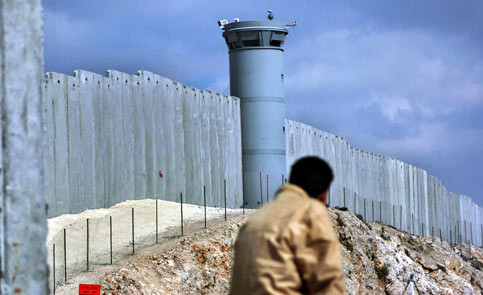B'Tselem 9 July 2006

A general view of the construction site of the Israeli separation wall in Qalandiya between Ramallah and Jerusalem March 18, 2006. (MaanImages/Moamar Awad)
Two years ago today [9 July 2004], the International Court of Justice, in The Hague , gave its advisory opinion on the Separation Barrier. The judges held that building the barrier in the West Bank violates international law. Thus, the court held, Israel must tear down the sections that stray from the Green Line, cancel the accompanying permit regime, and compensate Palestinians whose rights were violated by the barrier. The court also urged the UN General Assembly and the Security Council to consider actions to end the illegal situation created following construction of the barrier in the West Bank.
Despite the court’s opinion, Israel has continued to build the barrier inside the West Bank. The planned length of the barrier is, at the present time, 700 kilometers: fifty-one percent has been completed, thirteen percent is under construction, and construction has not begun on thirty-six percent.
Some eighty percent of the planned route lies inside the West Bank, with the remaining twenty percent running along the Green Line. Upon completion of the barrier, 8.5 percent of the West Bank (including East Jerusalem ) will be situated in the “seam zone,” the area between the barrier and the Green Line. This area contains sixty settlements (including twelve in East Jerusalem), in which some 381,000 Israelis live (192,000 in East Jerusalem).
The ICJ held that, despite Israel’s contention that security considerations alone were taken into account in setting the route, there is a suspicion that the barrier will establish “completed facts” that will lead to Israel ‘s de facto annexation of the seam zone, in violation of the right of the Palestinian people to self-determination. According to B’Tselem’s joint research with Bimkom, the main consideration in setting the route along twelve sections of the barrier was the desire to place west of the barrier lands that are intended for settlement expansion. In one of the cases, the Israeli Iigh Court has confirmed that the central consideration in setting the route was the existence of an unapproved settlement expansion plan, and that the information provided by the state in the matter was false.
As a result of the barrier’s construction in the West Bank, seventeen Palestinian towns and villages, in which 27,500 Palestinians reside, will be situated, following completion of the barrier, in the “seam zone”. The residents will have to obtain permits from the Israelis to continue living in their homes. Another 220,000 Palestinians, who live in East Jerusalem, will also find themselves living west of the barrier and will have to cross checkpoints and hold permits to allow them to go to various parts of the West Bank. Tens of thousands of other Palestinians who own land in the “seam zone” will have to obtain permits to enter and work their farmland. Past experience has shown that the permit regime severely impairs the right of thousands of Palestinians to freedom of movement, to work, and to gain a livelihood.
In addition, the barrier will surround part or all of 3.4 percent of the West Bank, in which 248,000 Palestinians live in fifty-four towns and villages. These communities will be surrounded by the barrier, but the residents will not need permits or have to cross checkpoints to get to other areas in the West Bank. However, the barrier will reduce the possibility of the communities’ urban development and will limit the freedom of movement of their residents.
On 30 April 2006, the government of Israel approved a revised route that was supposed to reduce the harm to the Palestinians’ fabric of life. However, the changes have a marginal overall effect. The new route, which is thirty kilometers longer than the old route, will reduce the land in the seam zone by one percent. Also, it removes four Palestinian villages, which have 2,300 residents, from the seam zone. On the other hand, one village, which is home to 900 persons, is placed inside the seam zone. The route in the bloc of settlements around Ariel (“the fingers”) was also changed, but without altering the number of settlements on the Israeli side or the number of Palestinian communities that will be surrounded partially or completely by the barrier.
Related Links